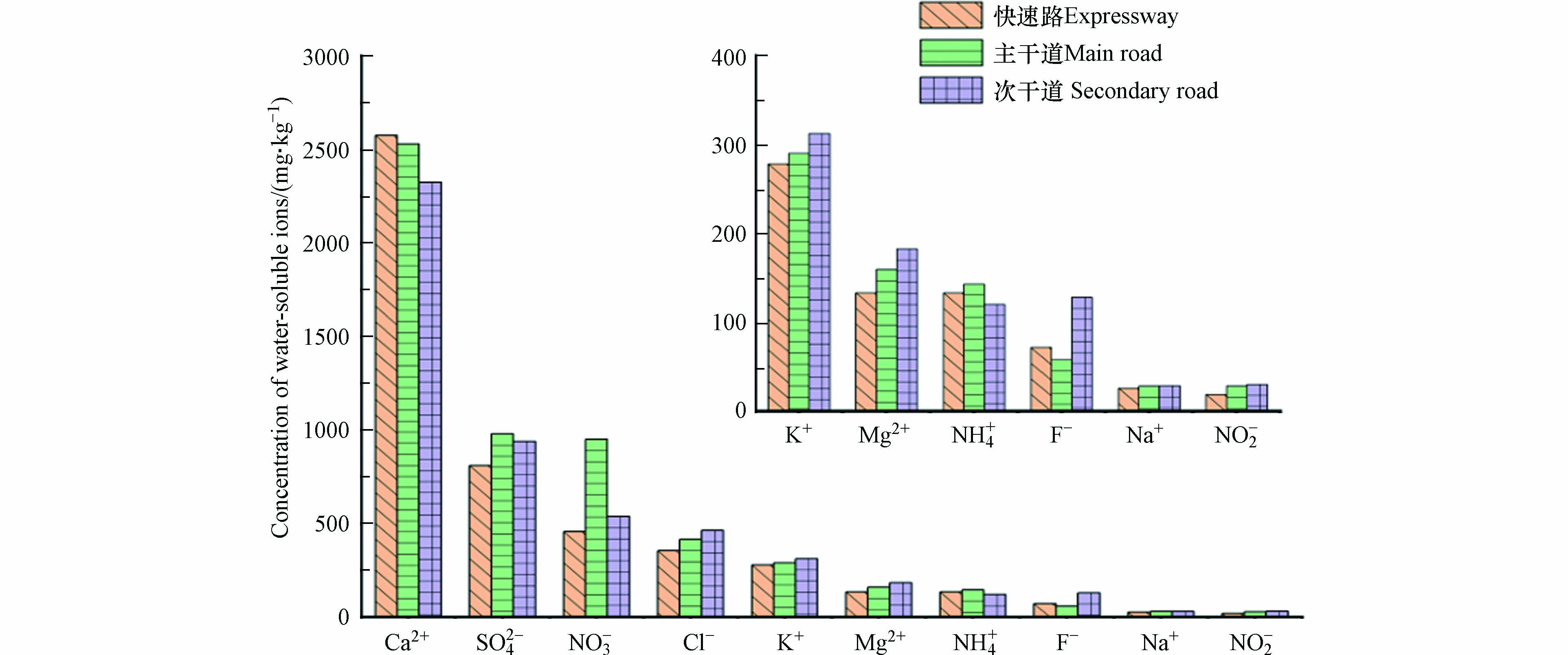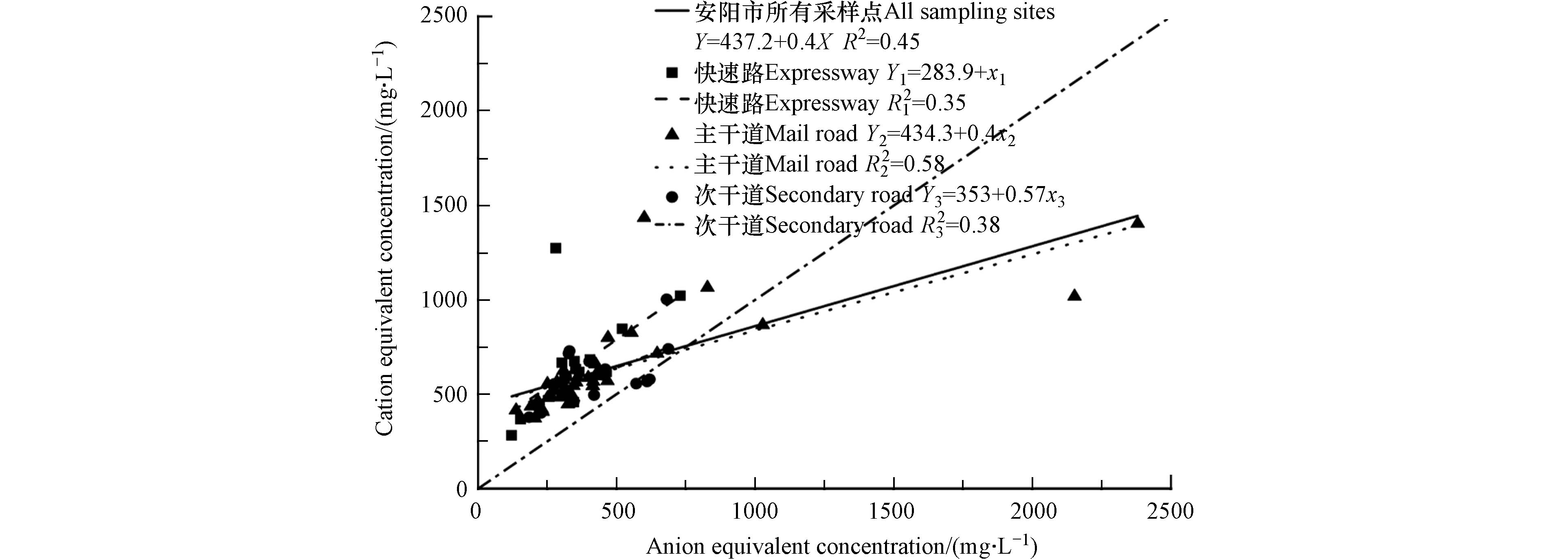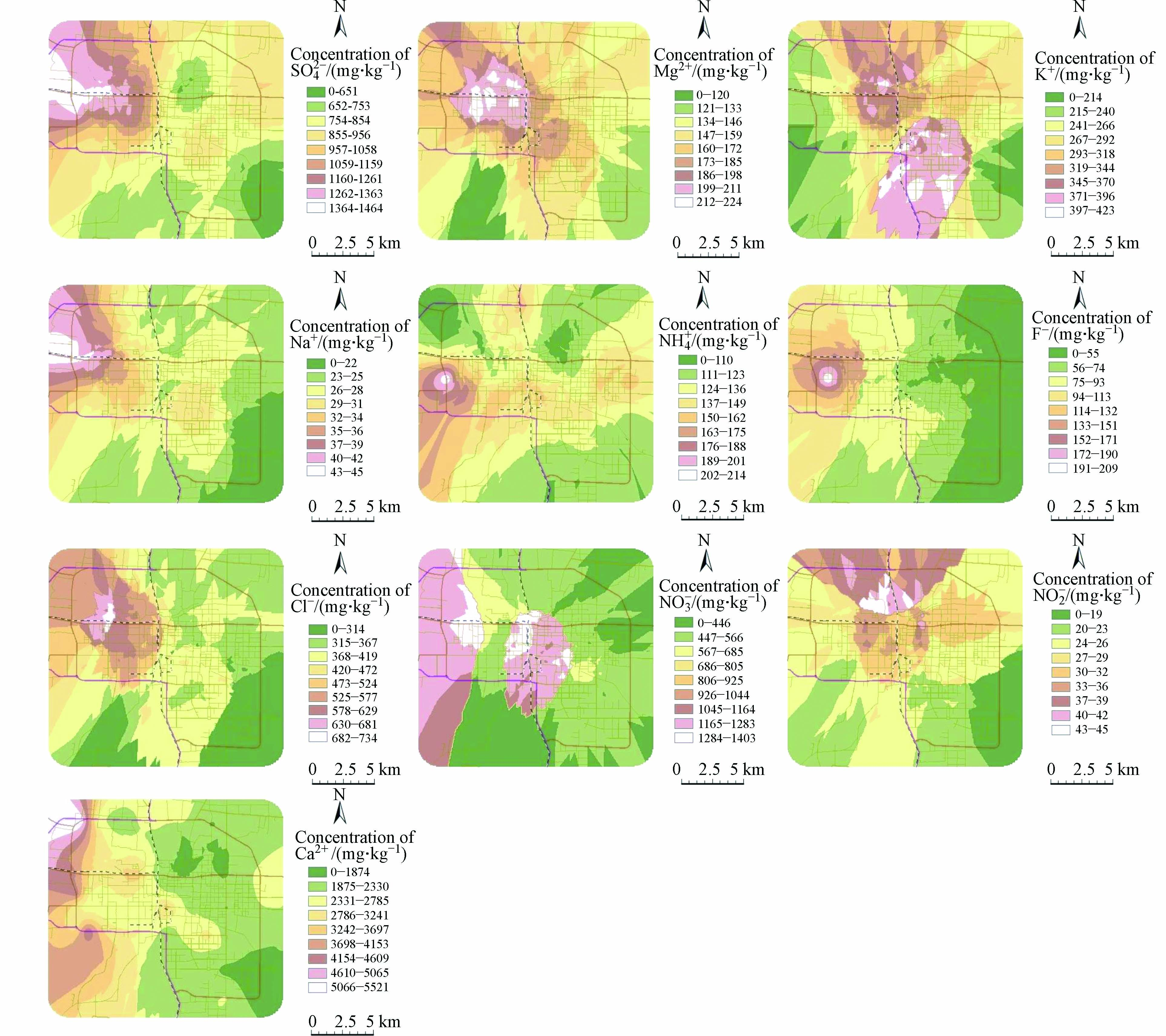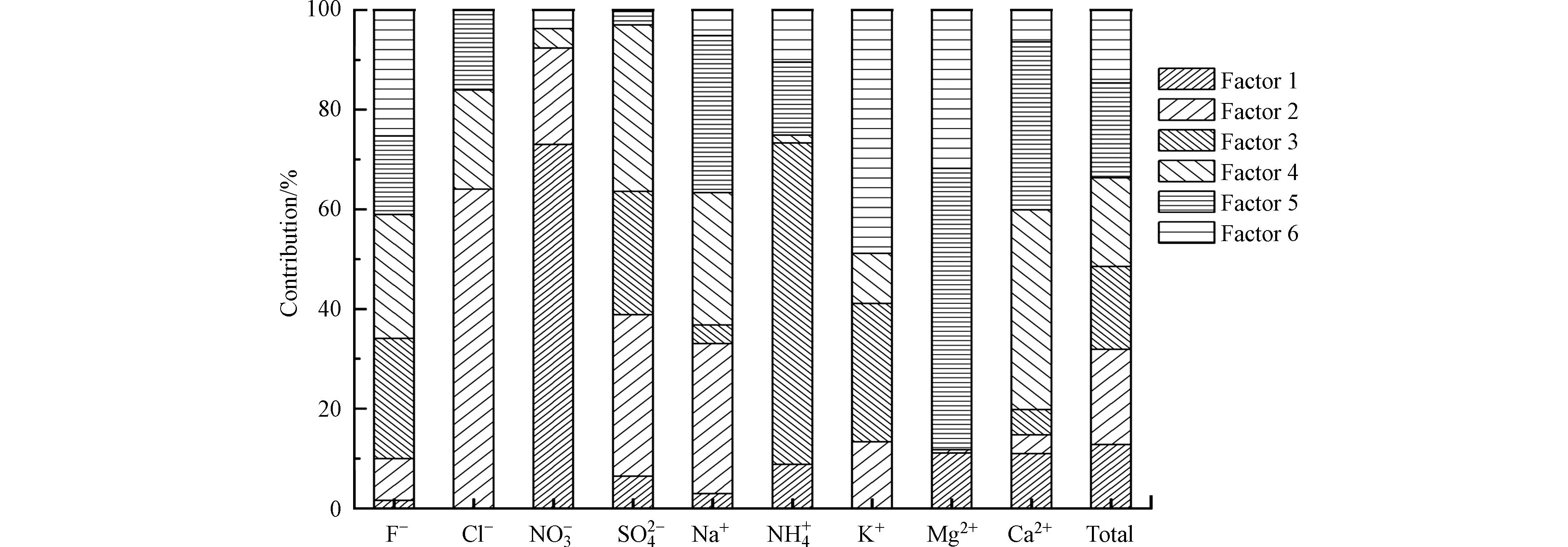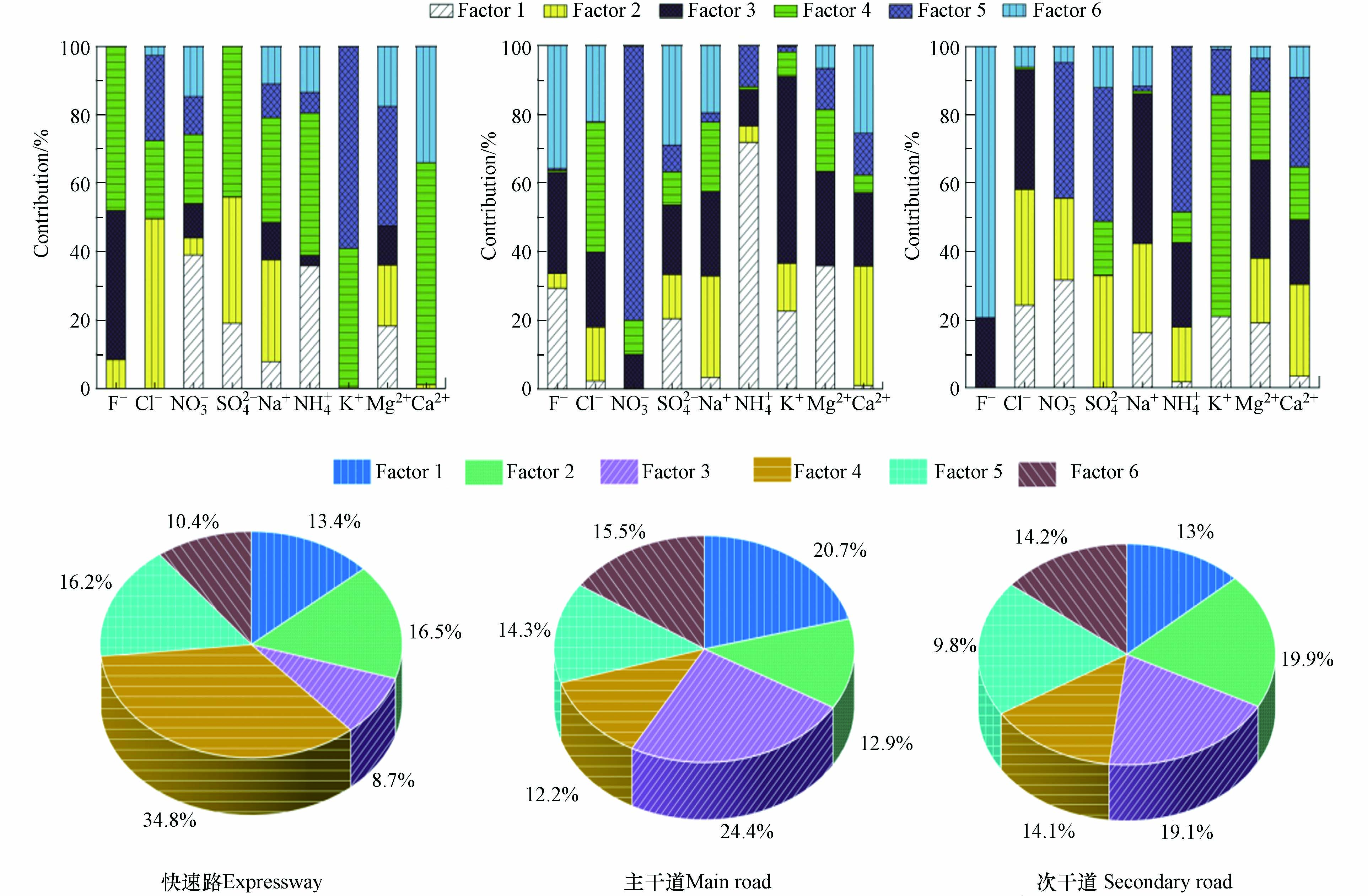-
随着工业化和城市化的快速发展,城市道路交通愈加发达,机动车保有量逐年增加[1],这极大加剧了道路积尘污染. 道路积尘是大气颗粒物(PM10和PM2.5)的主要来源之一,其成分复杂,包含重金属、多环芳烃、微塑料和碳质组分等颗粒态污染物[2]. 研究表明,水溶性离子易与水结合而具有表面活性剂的作用[3]. 道路积尘中颗粒态污染物会依附在水溶性离子表面从而进入人体,其毒性和被人体吸收的效率会在水溶性离子的催化作用下得到增强,对人体健康产生严重危害[4-5]. 此外,道路积尘具有较强的吸湿能力,能够直接影响大气环境及大气降水的酸碱度. 其中,水溶性离子的消光系数与雾霾污染程度呈正相关,二次离子(NO3−、SO42−、NH4+)对大气能见度有较强影响[6]. 因此,分析道路积尘的水溶性无机离子组成特征及其排放源对大气污染防治至关重要.
目前,国内学者开展了大量关于道路积尘负荷和排放特征的研究. 如刘俊芳等[7]探讨了北京市丰台区不同环线区域内车流量和道路积尘负荷的变化规律,发现车流量与道路积尘负荷、排放强度呈反向关系. 郭硕等[8]研究了石家庄市夏季机动车道道路积尘负荷及排放因子,结果表明车速对再悬浮的PM2.5浓度影响较大,对再悬浮的PM10浓度影响较小. 杨乃旺等[9]基于积尘负荷法对西安市4种类型道路的道路积尘排放特征研究发现,扬尘排放系数在次干路最大,支路次之,快速路和主干路最小. 杨德容等[10]采用AP-42排放因子模型与地理统计分析相结合的方法对成都市区及郊区道路积尘进行研究,发现中心城区中天府广场附近道路扬尘中PM10和PM2.5排放量较大,主要受道路密度和车辆流量影响. 已有研究对理解道路积尘的积尘负荷和排放特征有重要的意义,然而对道路积尘水溶性离子的污染特征及来源分析仍未见报道. 特别是作为“2+26”城市京津冀大气污染传输通道上的安阳市,道路积尘方面的研究少之又少.
近几十年,安阳市工业生产规模和机动车保有量逐年递涨,加剧了大气污染. 2015—2020年,安阳市PM2.5和PM10的年平均浓度在河南省18个省辖市中排名皆在前三,远超《环境空气质量标准》(GB 3095—2012)二级标准限值[11]. 因此,本研究以安阳市夏季道路积尘为研究对象,通过比值法分析道路积尘中水溶性离子的组成和污染特征,使用地理统计分析和正定矩阵模型确定道路积尘中水溶性离子来源,以期为安阳市探究大气污染源头和治理措施提出提供数据支持.
-
如图1所示,安阳市(E 113°37′ — 114°58′、N 35°12′ — 36°22′)位于河南省最北部,居河南、山西、河北三省交界处[12]. 安阳市气候属于暖温带大陆性季风气候,年平均气温14 ℃,年降雨量600 mm,降雨通常发生在夏季6—8月,冬季主导风向为东北风,夏季主导风向为西南风[13]. 根据《安阳市统计年鉴2021年》,安阳市2019年全市共计消耗3495.4万t标准煤,生产总值2393.2亿元,其中第二产业占46.2%[14],工业产品主要为粗钢、生铁、焦炭和水泥. 其中,粗钢产量为1433.1万t,钢材产量为1501.0万t,生铁产量为1399.3万t,水泥产量为596.8万t [15].
-
根据《安阳市中心城区道路交通规划图2007—2020》[16],于2020年5月7至5月13日使用手持式便携吸尘器(型号:戴森V8 Fluffy)共采集70个道路积尘样品,其中快速路17个、主干道36个和次干道17个. 采样时避开湿滑路面和大块散落土块等明显污染物,每个样品的采样距离约为200 m,每个样品采集的是混合样,每个样品重量约为200 g. 每个采样点采样结束后,使用湿巾和酒精清洗吸尘器吸头、吸尘杆、滤网和集尘筒,并用吹风机吹干吸尘器各部件,避免样本交叉污染. 样品带回实验室后,先用塑料夹子剔除大块砂砾、碎石、毛发、树叶等异物,并在40 ℃下干燥直到恒重. 最后,依次过100目和200目筛子得到道路积尘细样,置于自封袋内,待实验室分析.
-
根据《环境空气颗粒物中水溶性阳离子(Li+、Na+、NH4+、K+、Ca2+、Mg2+)测定离子色谱法》(HJ800—2016)和《环境空气颗粒物中水溶性阴离子(F−、Cl−、NO2−、NO3−、SO42−)的测定离子色谱法》(HJ799—2016)测定水溶性离子[17]. 首先,称取0.10 g样品于聚酯瓶中,用离子水定容至40 mL. 将聚酯瓶置于振荡器中,110 r·min−1振荡4 h. 振荡后的溶液用离心机4000 r·min−1离心4 min. 采用离子色谱仪(皖仪IC6600)测定道路积尘中水溶性离子含量,利用0.45 μm针头过滤器对待测滤液过滤,按采样标号依次放入仪器中. 每测定10个样品,进行一次单点校准和空白测定,其测量误差均在10%以内,阴阳离子的平均相对标准偏差分别为3.0%和4.0%,满足质控要求.
-
克里金插值法是一种使用广泛无偏差的插值方法[18-19]. 该方法基于区域化变量理论,考虑采样点间的相互关系,并对每一个观测点赋予一定的权重系数,加权平均得到估计值[20]. 计算公式为:
式中,
Z(x0) 为未采样现场的估计值;λi 和z(xi) 表示未采样点相邻位点的权重系数和值. -
正定矩阵模型(EPA PMF 5.0)是在非负约束的条件下对各采样点水溶性离子实际含量数据(非标准化数据)进行最小二乘法分析确定污染源因素[21-24],并通过剔除异常值使Min.
R2 大于80%、所有因子均为正值、所有因素累积解释大于80%的总方差,这使得水溶性离子污染源判别更加可信[25]. 根据EPA PMF 5.0用户指南,计算公式为:式中,
xij 是水溶性离子j在样品i中的含量,gik 是在i样本中的第k个污染源因子的贡献矩阵;fkj 是第k个污染源因子的水溶性离子元素j的源曲线;eij 是指在i个样本中金属元素j的残值[26].通过最小化目标函数Q的正定矩阵模型得到最优含量矩阵和源剖面,计算公式为:
式中,
uij 是在第i个样品中水溶性离子元素j的不确定度. 正定矩阵模型需要输入样品不确定数据文件. 当水溶性离子含量小于或等于检测仪器对应元素的方法检测限(MDL)时,uij 的计算公式为:当水溶性离子含量大于MDL时,
uij 的计算公式为:式中,c为水溶性离子含量(mg·kg −1 ),
σ 为误差分数(10%),是测量不确定度的百分比[27]. 依次设定不同因子数(3—8个),采用Robust模式,运算次数设为20次,随机选择初始点依次运行正定矩阵模型. 比较不同因子数下Qrob/Qexp (Qrob 为正定矩阵模型在Robust模式下得到的目标函数Q 的最优解,Qexp 为目标函数Q 的真值. 其中,Qexp =n×m'–p×(n+m') ,m' 为“Strong”变量的数目)的变化情况来确定,一般在Qrob/Qexp 快速下降处确定最佳因子数. 经试算,最终确定最佳因子数为6. 此时,除了F−(0.16)之外,其它阴阳离子的实测值与模型预测值之间的拟合曲线的R2 均大于0.8,这说明正定矩阵模型结果可靠. -
安阳市道路积尘样品中10种水溶性离子浓度值如图2和图3所示. 安阳市道路积尘中10种阴阳离子平均质量分数从大到小依次为:Ca2+(47.2%)> SO42−(17.6%)> NO3−(13.8%)> Cl−(7.8%)> K+(5.5%)> Mg2+(3.0%)> NH4+(2.6%)> F−(1.5%)> Na+(0.5%)> NO2−(0.5%). 在3种道路类型中,Ca2+、SO42−和NO3−含量浓度均在前三. 其中,Ca2+在快速路、主干道和次干道的占比分别为53.0%、45.3%和45.9%,道路积尘中Ca2+最高浓度高达6646.48 mg·kg−1,平均浓度为2491.34 mg·kg−1;SO42−在快速路、主干道和次干道的占比分别为16.7%、17.5%和 18.5%,道路积尘中SO42−最高浓度高达2499.23 mg·kg−1,平均浓度为928.36 mg·kg−1;NO3−在快速路、主干道和次干道的占比分别为9.4%、17%和10.6%,道路积尘中NO3−最高浓度高达9594.62 mg·kg−1,平均浓度为730 mg·kg−1. 与石家庄市[28](PM2.5中NO3−:5.27%、Cl−:7.13%、K+:1.28%、Mg2+:2.61%、NH4+:1.22%、F−:0.62%;PM10中NO3−:3.65%、Cl−:5.42%、K+:1.25%、Mg2+:2.53%、NH4+:1.01%、F−:0.51%)相比,NO3−、Cl−、K+、Mg2+、NH4+、F−百分含量较高;与济南市[29](Ca2+:30.2%、NO3−:10.1%、SO42−:33.7%)相比,Ca2+含量较高,但NO3−、SO42−含量较低. 二次离子NO3−、SO42−、NH4+在总水溶性离子中质量占比为34%;在快速路、主干道和次干道的质量占比分别为28.8%、37.1%和31.5%. 不同城市之间水溶性离子含量存在一定的差异,这可能是因为城市之间的机动车保有量不同和消耗能源存在差异等因素有关.
Ca2+作为地壳标识元素[30],其在3种道路类型中含量很高且相近,说明安阳市道路积尘主要受扬尘影响;NO3−在主干道中含量明显高于快速路和次干道. NO3−是由汽车尾气排放的NO、NO2、NOx通过光化学反应生成,且NO3−可以在特定的条件下形成硝酸盐进入颗粒物[31]. 安阳市道路交通发达,京广铁路、京港澳高速、南林高速穿插其中,主干道成为连接城市之间居民生活和交通运输的主要道路,其车流量明显高于快速路和次干道. NO3−、SO42−、NH4+是亲水性较强的离子,大部分由二次反应产生,在安阳市所有道路水溶性离子中占比34.0%,表明安阳市大气环境存在一定的二次污染[32]. 安阳市作为煤炭型城市,推断SO42−主要来源于燃煤[30];K+ 在3种道路类型积尘中含量相近,而K+主要在生物质燃烧过程产生[6]. 结合以上离子含量分布特征,初步判断安阳市道路积尘中水溶性离子受燃煤、扬尘、机动车尾气、生物质燃烧等因素的影响.
-
研究显示,阴离子过多时,会使颗粒物呈酸性;阳离子过多时会增加颗粒物的碱性[33-34]. 阴离子和阳离子摩尔数值可确定颗粒物的酸碱性,计算公式为:
式中,CE为阳离子所带电荷浓度(mmol·kg−1),AE为阴离子所带电荷浓度(mmol·kg−1),[]中为相应离子质量浓度(mg·kg−1).
CE/AE值小于1说明道路积尘总体呈酸性,大于1呈碱性. 安阳市道路积尘样品CE/AE值为3.25,阳离子当量高于阴离子当量;快速路、主干道、次干道CE/AE比值分别为4.05、3.06、3.33,阳离子当量高于阴离子当量. 目前,对水溶性离子酸碱性的判断通常用相关性斜率,相关性斜率小于1呈酸性、大于1呈碱性[28]. 对安阳市道路积尘中阴阳离子做相关性分析(图4),两者相关性斜率为0.4,R2为0.45. 分别对3种类型道路积尘中阴阳离子做相关性分析(图4),快速路、主干道、次干道相关性斜率分别为1.0、0.4、0.57,R2分别为0.35、0.58、0.38. 导致相关性斜率偏差较大的原因是主干道与次干道采样点中有6个点位SO42−和NO3−浓度异常,R2值偏低也是由于这6个点位SO42−和NO3−浓度异常. NO3−和SO42−是极为重要的二次离子,其中SO42−主要是由煤炭燃烧所释放的SO2转化而来,多为固定源排放. 安阳市夏季温度高、雨水丰沛,这有利于大气中SO42−的生成和沉降[35];NO3−主要由石油、天然气等化石燃料燃烧产生的NOx所转化,多为移动源排放. 因此,NO3−和SO42−的浓度之比可以用来比较燃煤等固定排放源和机动车等移动排放源的相对贡献[36]. 由图4可知采样点数据绝大多数在1 : 1线上方,样品中阳离子当量浓度大于阴离子当量浓度,表明道路积尘总体偏碱性,3种类型道路积尘都呈碱性且快速路道路积尘碱性最强. 样品中阳离子占比较大,尤其是Ca2+. 由此可见,Ca2+占比高导致的道路扬尘呈碱性可能是普遍规律[37]. Ca2+多来自于被车辆扬起的地表扬尘和建筑扬尘. 结合采样时间和采样点位置,推测是采样点附近的机动车排放和煤燃烧对道路尘成分造成影响,使得这6个采样点阴离子占比增加.
安阳市道路积尘中NO3−/ SO42−的比值为0.79,说明受固定源影响较大. 安阳市NO3−/ SO42−的比值低于上海市(2.14)[38],但高于运城市(0.02)[39]和石家庄市(0.24)[28],这可能是由于不同城市之间汽车保有量与煤炭燃烧情况不同所造成的. 随着汽车保有量的不断增加,汽车尾气的排放也随之增加,移动源排放得到补充;工业的迅速发展,导致煤炭的需求量急剧增长,固定源排放得到补充. 上海市重工业数量低于运城市、石家庄市和安阳市,但机动车保有量高于运城市、石家庄市和安阳市,所以上海市移动源排放占主. 安阳市、石家庄市和运城市工业发达,导致固定源排放增加.
-
本研究利用克里金插值法对安阳市夏季道路积尘水溶性离子进行插值,不同水溶性离子的空间分布图(图5). Ca2+在研究区域的西北部浓度普遍较高,浓度范围在4000—4700 mg·kg−1内;由研究区域西北部到西部,Ca2+浓度逐渐降低,但整体浓度也较高,在3300—4000 mg·kg−1的范围之内. 总体来看,Ca2+在空间分布特征图上的分布是从西往东逐渐降低,研究区域西北偏西为工业区、西北偏北为农田,西部附近有大量农田,西南部道路密集,推测Ca2+分布特征与此有关. 研究区域西北偏西为工业区,燃煤消耗较多,SO42−总体空间分布于Ca2+的空间分布较为相似,都是从西向东逐渐降低. 与Ca2+不同的是,SO42−在西北部区域内由中心往四周逐渐降低. Na+和Mg2+、Cl−的空间分布相似度较高,在研究区域的西北部集中分布. 其中,Na+、Mg2+和Cl−在分布中心浓度范围分别为41—46 mg·kg−1、227—261 mg·kg−1和655—765 mg·kg−1. 研究区域西北部、西部附近均有农田分布,西南部人口密集. NH4+分布较其他离子有所不同,高浓度区域分布较为零散,但总体在研究区域西南部浓度较高、南部和北部浓度较低. K+在研究区域北部及中部浓度较高,浓度范围为383—441 mg·kg−1. 高浓度NO3−在研究区域呈两点式分布且高度集中,浓度范围为1165—1403 mg·kg−1,研究区域西部有工业区,车辆运输频繁;研究区域中部道路分布密集.
根据水溶性离子在研究区域的空间分布特征及安阳市当地情况,可知离子分布情况与研究区域内存在的钢铁工业区有关. 钢铁工业区燃煤及工艺流程所排放颗粒物Ca2+、SO42−和Cl−的空间变化具有较高相似性,高值主要集中在研究区域西部以及安钢厂附近,且距离影响因子越近的离子相应浓度也就越大. 安阳市气候属于暖温带大陆性季风气候,受季风影响主要离子浓度的高值区也具有一致性. 结合以上分析可以得出,安阳市道路积尘中不同水溶性离子浓度的空间分布与研究区域内影响因子有极为密切的联系.
-
水溶性离子间的相关性分析不仅可以揭示道路积尘中离子间的结合方式,而且可以有效指示相同物质来源或迁移途径[40]. 本研究通过使用SPSS软件对水溶性离子进行皮尔森相关性分析(表1). 安阳市道路积尘中Mg2+与Cl−、SO42−,Na+与Cl−、SO42−,NH4+与NO3−,Ca2+与SO42−等有较高的相关系数. 在显著水平为0.01时,SO42−与Na+、Mg2+、Ca2+的相关性显著且为正相关,相关系数分别达到0.60、0.55、0.70,可能的存在形式为Na2SO4、MgSO4、CaSO4. SO42−与NO3−相关系数为0.41,且并未达到显著水平,这可能与安阳市存在着一定二次污染有关. SO42−与Na+、Mg2+、Ca2+的强相关性高于NH4+,推测可能与道路积尘本身的采集属性有关,而并非与大气环境中的生成属性有关. 一般来说夏季由于高温,硝酸铵极易分解为氨气和气态硝酸,而本研究中NO3−和NH4+却有较高的正相关系数(0.57),推测可能与道路积尘本身的特殊性以及研究区域气象条件不利于硝酸铵的分解有关. Cl−与Na+、Mg2+的相关性显著且为正相关,相关系数分别达到0.88和0.61,说明道路积尘中钠盐和镁盐的可能存在形式为NaCl和MgCl2. Mg2+与Na+、K+之间具有较高正相关系数,分别达到0.51、0.56,有较高的同源性,说明其可能来自相同来源. 根据以上各水溶性离子间的相关系数可知,安阳市道路积尘中硫酸盐的形成受多种机制共同作用.
-
利用正定矩阵模型对安阳市道路积尘水溶性离子进行来源解析,结果如图6所示. 因子1在NO3−上有较大有分布,NO3−通常来源于机动车尾气和其他燃烧过程排放的氮氧化物的转化[41],NO3−空间分布显示其高值区主要集中与研究区域中部和工业区附近,研究区域中部道路密集,工业区附近运输车辆频繁来往. 因此,推断因子1代表机动车尾气源;在因子2中, Cl−的贡献占比为64%,SO42−的贡献占比为38.9%. Cl−主要来源于垃圾焚烧、海盐、燃煤和工业生产过程等,SO42−主要来源于燃煤[42],本研究区域内钢铁工业区使用的燃煤和工艺流程中所排放的颗粒物情况;SO42−和Cl−的空间分布高度相似且离子高值区集中于钢铁工业区;相关性分析中,显著水平为0.01时,SO42−和Cl−的相关性显著为正相关,相关系数为0.58,结合以上因素得出其主要来源为燃煤源,故推断因子2为燃煤源;因子3中主要是NH4+,贡献占比为64.5%. NH4+主要来源于农业生产活动,采样点附近人口密集,农业生产活动频繁,NH4+的空间分布也显示其离子高值区在农田分布区,故推断因子3为农业源;在因子4中,Ca2+、SO42−、Na+、F−等离子含量相近,无主要标识离子,Ca2+、Na+主要来源于土壤扬尘[5],Ca2+与Na+的空间分布具有高度相似性,SO42−主要来源于燃煤[42],F−主要来源于工业生产[43],所以确定因子4为燃煤、扬尘和工业排放的混合源;在因子5中,Mg2+、Ca2+贡献率占比较大,贡献占比分别为56.5%、33.7%, Mg2+和Ca2+作为土壤扬尘的代表[5],属于地壳元素,该类源可能是土壤尘、再悬浮的道路尘、人为建筑尘等扬尘源的混合体,由空间分布可知,Mg2+和Ca2+的离子高值区主要在研究区域的西部,且安阳市道路交通发达,采样点附近建筑施工场地较多,结合以上因素推断因子5代表扬尘源;在因子6中,K+是最主要的离子,K+贡献占比为58.9%,K+主要在生物质燃烧过程产生[44],是生物质燃烧的标志性元素. 因此,推断因子6为生物质燃烧源.
由图6中总因子贡献率可知,机动车尾气源、燃煤源、农业源、混合源、扬尘源和生物质燃烧源对安阳市道路积尘水溶性离子的贡献占比分别是12.8%、19.1%、16.6%、17.8%、19.0%和14.7%. 燃煤源、扬尘源对安阳市道路积尘水溶性离子的贡献分别为第一和第二,这与安阳市整体工业结构及道路交通情况有关. 由图7可知,3种类型道路积尘中,燃煤、扬尘和工业排放的混合源在快速路中贡献占比高达34.8%,农业源与机动车尾气源在主干道中贡献占比分别为24.4%、20.7%,燃煤源、扬尘源和农业源在次干道中贡献占比分别为19.9%、19.8%、19.1%. 安阳作为河南省重工业基地之一,现有7个产业集聚区和22个专业园区. 近年来,安阳市工业总体呈现逐年递增的趋势,占全市经济总量比例越来越高. 2018年安阳市第二产业占比为经济总量的46.2%[45],工业的迅速发展势必会加剧安阳市大气污染. 根据实地调查情况,发现采样点附近人口较为密集且采样期间周边存在机动车运输现象,由于采样时段处于五月中旬,研究区域内存在个别农业现象,生物质燃烧等农业排放源得到补充,进而贡献安阳市大气污染.
-
(1)安阳市道路积尘10种水溶性离子含量从大到小依次为:Ca2+ > SO42−> NO3−> Cl−> K+ > Mg2+ > NH4+ > F−> Na+ > NO2−. 二次离子NO3−、SO42−、NH4+在快速路、主干道和次干道的质量占比分别为28.8%、37.1%和31.5%. 经NO3−与SO42−比值分析, 安阳市道路积尘主要受固定源影响.
(2)Ca2+、SO42−空间分布较相似,Na+和Mg2+、Cl−空间分布相似,安阳市道路积尘中不同水溶性离子浓度的空间分布与研究区域内影响因子有极为密切的联系,距离影响因子越近的离子浓度也就越大.
(3)对安阳市道路积尘水溶性离子做相关性分析发现,10种水溶性离子以多种形式存在. Mg2+与Cl−、SO42−,Na+与Cl−、SO42−,NH4+与NO3−,Ca2+与SO42−有较高同源性. 硫酸盐存在形式为MgSO4、Na2SO4、CaSO4,NH4+与NO3−结合成NH4NO3.
(4)利用正定矩阵模型对安阳市道路积尘水溶性离子进行来源解析,结果表明安阳市道路积尘来源与机动车排放、农业生产活动排放、燃煤及生物质燃烧、道路尘和建筑尘有关. 其中燃煤源与扬尘源对安阳市道路积尘的贡献分别为第一和第二.
安阳市夏季道路积尘水溶性离子污染特征及来源分析
Pollution characteristics and source analysis of water-soluble ions in road dust in Anyang city during summer
-
摘要: 为了解安阳市夏季道路积尘水溶性离子污染特征及来源,于2020年5月使用手持式便携吸尘器采集70个城市道路积尘样品,经离子色谱仪测定其中10种水溶性离子(F−、Cl−、NO2−、NO3−、SO42−、K+、Na+、Ca2+、Mg2+、NH4+),用比值分析法和相关性分析法分析其污染特征,结合地理统计分析和正定矩阵模型判断其主要来源. 结果表明,Ca2+、SO42−、NO3−、Cl−、K+在安阳市道路积尘水溶性离子中占比较大,其中Ca2+占比最高,SO42−和NO3−次之. 在3种道路类型中,Ca2+在快速路、主干道和次干道的占比分别为53.0%、45.3%和 45.9%;SO42−在快速路、主干道和次干道的占比分别为16.7%、17.5%和 18.5%. NO3−/ SO42−的比值为0.79,说明固定源的贡献更大;水溶性阴阳离子相关性斜率(0.42)小于1,道路积尘呈碱性. 安阳市道路积尘中Ca2+与SO42−,Na+与Mg2+和Cl−空间分布相似,其高值区主要集中在研究区域的西北部和西南部. 安阳市夏季道路积尘中水溶性离子的主要来源为机动车尾气源、燃煤源、农业源、混合源、扬尘源和生物质燃烧源,其贡献率分别为12.8%、19.1%、16.6%、14.7%和19.0%. 以期为安阳市探究道路积尘污染源头和治理措施提出提供数据支持.Abstract: To understand the pollution characteristics and sources of water-soluble ions in road dust in Anyang City during summer, 70 road dust samples were collected by a hand-held portable vacuum cleaner in May 2020 in this study, and 10 water-soluble ions (F−、Cl−、NO2−、NO3−、SO42−、K+、Na+、Ca2+、Mg2+、NH4+) were measured by ion chromatography. Ratio analysis and correlation analysis were used to analyze the pollution characteristics, and geographical statistical analysis and positive matrix factorization model were used to determine the main sources of water-soluble ions. The results showed that Ca2+、SO42−、NO3−、Cl−、K+ accounted for a large proportion of water-soluble ions in road dust from Anyang City, and Ca2+ accounted for the highest proportion, followed by SO42−and NO3−. Among the three types of roads, Ca2+ accounts for 53.0%, 45.3% and 45.9% of expressways, main roads and secondary roads respectively. SO42−accounted for 16.7%, 17.5% and 18.5% of expressways, main roads and secondary roads, respectively. The ratio of NO3−/ SO42−was 0.79, which showed that the contribution of stationary sources was greater than mobile exhaust. The correlation slope of water-soluble anion and anion (0.42) is less than 1, indicating that road dust was alkaline. The spatial distribution of Ca2+ and SO42−, Na+ and Mg2+ and Na+ and Cl− in road dust of Anyang City were similar, and the high-value areas were mainly concentrated in the northwest and southwest of the study area. The main sources of water-soluble ions in road dust in Anyang City were vehicle exhaust sources, coal sources, agricultural sources, mixed sources, dust sources and biomass combustion sources, and their contribution rates were 12.8%, 19.1%、16.6%, 14.7% and 19.0%, respectively. To provide data support for Anyang city to explore the source of road dust and put forward control measures.
-
Key words:
- Anyang city /
- road dust /
- water-soluble ions /
- spatial distribution /
- sources analysis.
-
随着工业化和城市化的快速发展,城市道路交通愈加发达,机动车保有量逐年增加[1],这极大加剧了道路积尘污染. 道路积尘是大气颗粒物(PM10和PM2.5)的主要来源之一,其成分复杂,包含重金属、多环芳烃、微塑料和碳质组分等颗粒态污染物[2]. 研究表明,水溶性离子易与水结合而具有表面活性剂的作用[3]. 道路积尘中颗粒态污染物会依附在水溶性离子表面从而进入人体,其毒性和被人体吸收的效率会在水溶性离子的催化作用下得到增强,对人体健康产生严重危害[4-5]. 此外,道路积尘具有较强的吸湿能力,能够直接影响大气环境及大气降水的酸碱度. 其中,水溶性离子的消光系数与雾霾污染程度呈正相关,二次离子(NO3−、SO42−、NH4+)对大气能见度有较强影响[6]. 因此,分析道路积尘的水溶性无机离子组成特征及其排放源对大气污染防治至关重要.
目前,国内学者开展了大量关于道路积尘负荷和排放特征的研究. 如刘俊芳等[7]探讨了北京市丰台区不同环线区域内车流量和道路积尘负荷的变化规律,发现车流量与道路积尘负荷、排放强度呈反向关系. 郭硕等[8]研究了石家庄市夏季机动车道道路积尘负荷及排放因子,结果表明车速对再悬浮的PM2.5浓度影响较大,对再悬浮的PM10浓度影响较小. 杨乃旺等[9]基于积尘负荷法对西安市4种类型道路的道路积尘排放特征研究发现,扬尘排放系数在次干路最大,支路次之,快速路和主干路最小. 杨德容等[10]采用AP-42排放因子模型与地理统计分析相结合的方法对成都市区及郊区道路积尘进行研究,发现中心城区中天府广场附近道路扬尘中PM10和PM2.5排放量较大,主要受道路密度和车辆流量影响. 已有研究对理解道路积尘的积尘负荷和排放特征有重要的意义,然而对道路积尘水溶性离子的污染特征及来源分析仍未见报道. 特别是作为“2+26”城市京津冀大气污染传输通道上的安阳市,道路积尘方面的研究少之又少.
近几十年,安阳市工业生产规模和机动车保有量逐年递涨,加剧了大气污染. 2015—2020年,安阳市PM2.5和PM10的年平均浓度在河南省18个省辖市中排名皆在前三,远超《环境空气质量标准》(GB 3095—2012)二级标准限值[11]. 因此,本研究以安阳市夏季道路积尘为研究对象,通过比值法分析道路积尘中水溶性离子的组成和污染特征,使用地理统计分析和正定矩阵模型确定道路积尘中水溶性离子来源,以期为安阳市探究大气污染源头和治理措施提出提供数据支持.
1. 材料与方法(Materials and methods)
1.1 研究区域
如图1所示,安阳市(E 113°37′ — 114°58′、N 35°12′ — 36°22′)位于河南省最北部,居河南、山西、河北三省交界处[12]. 安阳市气候属于暖温带大陆性季风气候,年平均气温14 ℃,年降雨量600 mm,降雨通常发生在夏季6—8月,冬季主导风向为东北风,夏季主导风向为西南风[13]. 根据《安阳市统计年鉴2021年》,安阳市2019年全市共计消耗3495.4万t标准煤,生产总值2393.2亿元,其中第二产业占46.2%[14],工业产品主要为粗钢、生铁、焦炭和水泥. 其中,粗钢产量为1433.1万t,钢材产量为1501.0万t,生铁产量为1399.3万t,水泥产量为596.8万t [15].
1.2 样品采集
根据《安阳市中心城区道路交通规划图2007—2020》[16],于2020年5月7至5月13日使用手持式便携吸尘器(型号:戴森V8 Fluffy)共采集70个道路积尘样品,其中快速路17个、主干道36个和次干道17个. 采样时避开湿滑路面和大块散落土块等明显污染物,每个样品的采样距离约为200 m,每个样品采集的是混合样,每个样品重量约为200 g. 每个采样点采样结束后,使用湿巾和酒精清洗吸尘器吸头、吸尘杆、滤网和集尘筒,并用吹风机吹干吸尘器各部件,避免样本交叉污染. 样品带回实验室后,先用塑料夹子剔除大块砂砾、碎石、毛发、树叶等异物,并在40 ℃下干燥直到恒重. 最后,依次过100目和200目筛子得到道路积尘细样,置于自封袋内,待实验室分析.
1.3 仪器与分析
根据《环境空气颗粒物中水溶性阳离子(Li+、Na+、NH4+、K+、Ca2+、Mg2+)测定离子色谱法》(HJ800—2016)和《环境空气颗粒物中水溶性阴离子(F−、Cl−、NO2−、NO3−、SO42−)的测定离子色谱法》(HJ799—2016)测定水溶性离子[17]. 首先,称取0.10 g样品于聚酯瓶中,用离子水定容至40 mL. 将聚酯瓶置于振荡器中,110 r·min−1振荡4 h. 振荡后的溶液用离心机4000 r·min−1离心4 min. 采用离子色谱仪(皖仪IC6600)测定道路积尘中水溶性离子含量,利用0.45 μm针头过滤器对待测滤液过滤,按采样标号依次放入仪器中. 每测定10个样品,进行一次单点校准和空白测定,其测量误差均在10%以内,阴阳离子的平均相对标准偏差分别为3.0%和4.0%,满足质控要求.
1.4 克里金插值法
克里金插值法是一种使用广泛无偏差的插值方法[18-19]. 该方法基于区域化变量理论,考虑采样点间的相互关系,并对每一个观测点赋予一定的权重系数,加权平均得到估计值[20]. 计算公式为:
Z(x0)=∑ni=1λi×z(xi) 式中,
Z(x0) λi z(xi) 1.5 正定矩阵模型
正定矩阵模型(EPA PMF 5.0)是在非负约束的条件下对各采样点水溶性离子实际含量数据(非标准化数据)进行最小二乘法分析确定污染源因素[21-24],并通过剔除异常值使Min.
R2 xij=∑pk=1(gikfkj+eij) 式中,
xij gik fkj eij 通过最小化目标函数Q的正定矩阵模型得到最优含量矩阵和源剖面,计算公式为:
Q=∑ni=1∑mj=1(xij−∑pk=1gikfkjuij)2=∑ni=1∑mj=1(eijuij)2 式中,
uij uij Uij=56MDL 当水溶性离子含量大于MDL时,
uij Uij=√(σ×c)2+(0.5×MDL)2 式中,c为水溶性离子含量(mg·kg −1 ),
σ Qrob/Qexp Qrob Q Qexp Q Qexp n×m'–p×(n+m') m' Qrob/Qexp R2 2. 结果与讨论(Results and discussion)
2.1 水溶性离子含量特征
安阳市道路积尘样品中10种水溶性离子浓度值如图2和图3所示. 安阳市道路积尘中10种阴阳离子平均质量分数从大到小依次为:Ca2+(47.2%)> SO42−(17.6%)> NO3−(13.8%)> Cl−(7.8%)> K+(5.5%)> Mg2+(3.0%)> NH4+(2.6%)> F−(1.5%)> Na+(0.5%)> NO2−(0.5%). 在3种道路类型中,Ca2+、SO42−和NO3−含量浓度均在前三. 其中,Ca2+在快速路、主干道和次干道的占比分别为53.0%、45.3%和45.9%,道路积尘中Ca2+最高浓度高达6646.48 mg·kg−1,平均浓度为2491.34 mg·kg−1;SO42−在快速路、主干道和次干道的占比分别为16.7%、17.5%和 18.5%,道路积尘中SO42−最高浓度高达2499.23 mg·kg−1,平均浓度为928.36 mg·kg−1;NO3−在快速路、主干道和次干道的占比分别为9.4%、17%和10.6%,道路积尘中NO3−最高浓度高达9594.62 mg·kg−1,平均浓度为730 mg·kg−1. 与石家庄市[28](PM2.5中NO3−:5.27%、Cl−:7.13%、K+:1.28%、Mg2+:2.61%、NH4+:1.22%、F−:0.62%;PM10中NO3−:3.65%、Cl−:5.42%、K+:1.25%、Mg2+:2.53%、NH4+:1.01%、F−:0.51%)相比,NO3−、Cl−、K+、Mg2+、NH4+、F−百分含量较高;与济南市[29](Ca2+:30.2%、NO3−:10.1%、SO42−:33.7%)相比,Ca2+含量较高,但NO3−、SO42−含量较低. 二次离子NO3−、SO42−、NH4+在总水溶性离子中质量占比为34%;在快速路、主干道和次干道的质量占比分别为28.8%、37.1%和31.5%. 不同城市之间水溶性离子含量存在一定的差异,这可能是因为城市之间的机动车保有量不同和消耗能源存在差异等因素有关.
Ca2+作为地壳标识元素[30],其在3种道路类型中含量很高且相近,说明安阳市道路积尘主要受扬尘影响;NO3−在主干道中含量明显高于快速路和次干道. NO3−是由汽车尾气排放的NO、NO2、NOx通过光化学反应生成,且NO3−可以在特定的条件下形成硝酸盐进入颗粒物[31]. 安阳市道路交通发达,京广铁路、京港澳高速、南林高速穿插其中,主干道成为连接城市之间居民生活和交通运输的主要道路,其车流量明显高于快速路和次干道. NO3−、SO42−、NH4+是亲水性较强的离子,大部分由二次反应产生,在安阳市所有道路水溶性离子中占比34.0%,表明安阳市大气环境存在一定的二次污染[32]. 安阳市作为煤炭型城市,推断SO42−主要来源于燃煤[30];K+ 在3种道路类型积尘中含量相近,而K+主要在生物质燃烧过程产生[6]. 结合以上离子含量分布特征,初步判断安阳市道路积尘中水溶性离子受燃煤、扬尘、机动车尾气、生物质燃烧等因素的影响.
2.2 阴阳离子平衡及NO3−与SO42−比值分析
研究显示,阴离子过多时,会使颗粒物呈酸性;阳离子过多时会增加颗粒物的碱性[33-34]. 阴离子和阳离子摩尔数值可确定颗粒物的酸碱性,计算公式为:
CE=[Na+]23+[NH4+]18+[K+]39+[Mg2+]12+[Ca2+]20 AE=[SO42−]48+[NO3−]62+[Cl−]35.5+[F−]19+[NO2−]46 式中,CE为阳离子所带电荷浓度(mmol·kg−1),AE为阴离子所带电荷浓度(mmol·kg−1),[]中为相应离子质量浓度(mg·kg−1).
CE/AE值小于1说明道路积尘总体呈酸性,大于1呈碱性. 安阳市道路积尘样品CE/AE值为3.25,阳离子当量高于阴离子当量;快速路、主干道、次干道CE/AE比值分别为4.05、3.06、3.33,阳离子当量高于阴离子当量. 目前,对水溶性离子酸碱性的判断通常用相关性斜率,相关性斜率小于1呈酸性、大于1呈碱性[28]. 对安阳市道路积尘中阴阳离子做相关性分析(图4),两者相关性斜率为0.4,R2为0.45. 分别对3种类型道路积尘中阴阳离子做相关性分析(图4),快速路、主干道、次干道相关性斜率分别为1.0、0.4、0.57,R2分别为0.35、0.58、0.38. 导致相关性斜率偏差较大的原因是主干道与次干道采样点中有6个点位SO42−和NO3−浓度异常,R2值偏低也是由于这6个点位SO42−和NO3−浓度异常. NO3−和SO42−是极为重要的二次离子,其中SO42−主要是由煤炭燃烧所释放的SO2转化而来,多为固定源排放. 安阳市夏季温度高、雨水丰沛,这有利于大气中SO42−的生成和沉降[35];NO3−主要由石油、天然气等化石燃料燃烧产生的NOx所转化,多为移动源排放. 因此,NO3−和SO42−的浓度之比可以用来比较燃煤等固定排放源和机动车等移动排放源的相对贡献[36]. 由图4可知采样点数据绝大多数在1 : 1线上方,样品中阳离子当量浓度大于阴离子当量浓度,表明道路积尘总体偏碱性,3种类型道路积尘都呈碱性且快速路道路积尘碱性最强. 样品中阳离子占比较大,尤其是Ca2+. 由此可见,Ca2+占比高导致的道路扬尘呈碱性可能是普遍规律[37]. Ca2+多来自于被车辆扬起的地表扬尘和建筑扬尘. 结合采样时间和采样点位置,推测是采样点附近的机动车排放和煤燃烧对道路尘成分造成影响,使得这6个采样点阴离子占比增加.
安阳市道路积尘中NO3−/ SO42−的比值为0.79,说明受固定源影响较大. 安阳市NO3−/ SO42−的比值低于上海市(2.14)[38],但高于运城市(0.02)[39]和石家庄市(0.24)[28],这可能是由于不同城市之间汽车保有量与煤炭燃烧情况不同所造成的. 随着汽车保有量的不断增加,汽车尾气的排放也随之增加,移动源排放得到补充;工业的迅速发展,导致煤炭的需求量急剧增长,固定源排放得到补充. 上海市重工业数量低于运城市、石家庄市和安阳市,但机动车保有量高于运城市、石家庄市和安阳市,所以上海市移动源排放占主. 安阳市、石家庄市和运城市工业发达,导致固定源排放增加.
2.3 水溶性离子空间分布特征
本研究利用克里金插值法对安阳市夏季道路积尘水溶性离子进行插值,不同水溶性离子的空间分布图(图5). Ca2+在研究区域的西北部浓度普遍较高,浓度范围在4000—4700 mg·kg−1内;由研究区域西北部到西部,Ca2+浓度逐渐降低,但整体浓度也较高,在3300—4000 mg·kg−1的范围之内. 总体来看,Ca2+在空间分布特征图上的分布是从西往东逐渐降低,研究区域西北偏西为工业区、西北偏北为农田,西部附近有大量农田,西南部道路密集,推测Ca2+分布特征与此有关. 研究区域西北偏西为工业区,燃煤消耗较多,SO42−总体空间分布于Ca2+的空间分布较为相似,都是从西向东逐渐降低. 与Ca2+不同的是,SO42−在西北部区域内由中心往四周逐渐降低. Na+和Mg2+、Cl−的空间分布相似度较高,在研究区域的西北部集中分布. 其中,Na+、Mg2+和Cl−在分布中心浓度范围分别为41—46 mg·kg−1、227—261 mg·kg−1和655—765 mg·kg−1. 研究区域西北部、西部附近均有农田分布,西南部人口密集. NH4+分布较其他离子有所不同,高浓度区域分布较为零散,但总体在研究区域西南部浓度较高、南部和北部浓度较低. K+在研究区域北部及中部浓度较高,浓度范围为383—441 mg·kg−1. 高浓度NO3−在研究区域呈两点式分布且高度集中,浓度范围为1165—1403 mg·kg−1,研究区域西部有工业区,车辆运输频繁;研究区域中部道路分布密集.
根据水溶性离子在研究区域的空间分布特征及安阳市当地情况,可知离子分布情况与研究区域内存在的钢铁工业区有关. 钢铁工业区燃煤及工艺流程所排放颗粒物Ca2+、SO42−和Cl−的空间变化具有较高相似性,高值主要集中在研究区域西部以及安钢厂附近,且距离影响因子越近的离子相应浓度也就越大. 安阳市气候属于暖温带大陆性季风气候,受季风影响主要离子浓度的高值区也具有一致性. 结合以上分析可以得出,安阳市道路积尘中不同水溶性离子浓度的空间分布与研究区域内影响因子有极为密切的联系.
2.4 水溶性离子来源解析
2.4.1 相关性分析
水溶性离子间的相关性分析不仅可以揭示道路积尘中离子间的结合方式,而且可以有效指示相同物质来源或迁移途径[40]. 本研究通过使用SPSS软件对水溶性离子进行皮尔森相关性分析(表1). 安阳市道路积尘中Mg2+与Cl−、SO42−,Na+与Cl−、SO42−,NH4+与NO3−,Ca2+与SO42−等有较高的相关系数. 在显著水平为0.01时,SO42−与Na+、Mg2+、Ca2+的相关性显著且为正相关,相关系数分别达到0.60、0.55、0.70,可能的存在形式为Na2SO4、MgSO4、CaSO4. SO42−与NO3−相关系数为0.41,且并未达到显著水平,这可能与安阳市存在着一定二次污染有关. SO42−与Na+、Mg2+、Ca2+的强相关性高于NH4+,推测可能与道路积尘本身的采集属性有关,而并非与大气环境中的生成属性有关. 一般来说夏季由于高温,硝酸铵极易分解为氨气和气态硝酸,而本研究中NO3−和NH4+却有较高的正相关系数(0.57),推测可能与道路积尘本身的特殊性以及研究区域气象条件不利于硝酸铵的分解有关. Cl−与Na+、Mg2+的相关性显著且为正相关,相关系数分别达到0.88和0.61,说明道路积尘中钠盐和镁盐的可能存在形式为NaCl和MgCl2. Mg2+与Na+、K+之间具有较高正相关系数,分别达到0.51、0.56,有较高的同源性,说明其可能来自相同来源. 根据以上各水溶性离子间的相关系数可知,安阳市道路积尘中硫酸盐的形成受多种机制共同作用.
表 1 水溶性离子相关性分析Table 1. Correlation analysis of water-soluble ionsF− Cl− NO2− NO3− SO42− Na+ NH4+ K+ Mg2+ Ca2+ F− 1 Cl− 0.23 1 NO2− 0.07 0.16 1 NO3− −0.04 −0.02 −0.09 1 SO42− 0.13 0.58** 0.19 0.41** 1 Na+ 0.42** 0.89** 0.22 0.03 0.60** 1 NH4+ −0.10 −0.16 0.06 0.57** 0.42** −0.07 1 K+ 0.09 0.37** 0.42** −0.03 0.33** 0.45** 0.243* 1 Mg2+ 0.15 0.61** 0.25* 0.46** 0.55** 0.51** 0.349** 0.56** 1 Ca2+ 0.10 0.35** 0.12 0.47** 0.70** 0.49** 0.22 0.14 0.19 1 **:在0.01级别(双尾),相关性显著;*:在0.05级别(双尾),相关性显著. **: At 0.01 level (double tail), the correlation is significant; *: At 0.05 level (two-tailed), the correlation is significant. 2.4.2 正定矩阵模型
利用正定矩阵模型对安阳市道路积尘水溶性离子进行来源解析,结果如图6所示. 因子1在NO3−上有较大有分布,NO3−通常来源于机动车尾气和其他燃烧过程排放的氮氧化物的转化[41],NO3−空间分布显示其高值区主要集中与研究区域中部和工业区附近,研究区域中部道路密集,工业区附近运输车辆频繁来往. 因此,推断因子1代表机动车尾气源;在因子2中, Cl−的贡献占比为64%,SO42−的贡献占比为38.9%. Cl−主要来源于垃圾焚烧、海盐、燃煤和工业生产过程等,SO42−主要来源于燃煤[42],本研究区域内钢铁工业区使用的燃煤和工艺流程中所排放的颗粒物情况;SO42−和Cl−的空间分布高度相似且离子高值区集中于钢铁工业区;相关性分析中,显著水平为0.01时,SO42−和Cl−的相关性显著为正相关,相关系数为0.58,结合以上因素得出其主要来源为燃煤源,故推断因子2为燃煤源;因子3中主要是NH4+,贡献占比为64.5%. NH4+主要来源于农业生产活动,采样点附近人口密集,农业生产活动频繁,NH4+的空间分布也显示其离子高值区在农田分布区,故推断因子3为农业源;在因子4中,Ca2+、SO42−、Na+、F−等离子含量相近,无主要标识离子,Ca2+、Na+主要来源于土壤扬尘[5],Ca2+与Na+的空间分布具有高度相似性,SO42−主要来源于燃煤[42],F−主要来源于工业生产[43],所以确定因子4为燃煤、扬尘和工业排放的混合源;在因子5中,Mg2+、Ca2+贡献率占比较大,贡献占比分别为56.5%、33.7%, Mg2+和Ca2+作为土壤扬尘的代表[5],属于地壳元素,该类源可能是土壤尘、再悬浮的道路尘、人为建筑尘等扬尘源的混合体,由空间分布可知,Mg2+和Ca2+的离子高值区主要在研究区域的西部,且安阳市道路交通发达,采样点附近建筑施工场地较多,结合以上因素推断因子5代表扬尘源;在因子6中,K+是最主要的离子,K+贡献占比为58.9%,K+主要在生物质燃烧过程产生[44],是生物质燃烧的标志性元素. 因此,推断因子6为生物质燃烧源.
由图6中总因子贡献率可知,机动车尾气源、燃煤源、农业源、混合源、扬尘源和生物质燃烧源对安阳市道路积尘水溶性离子的贡献占比分别是12.8%、19.1%、16.6%、17.8%、19.0%和14.7%. 燃煤源、扬尘源对安阳市道路积尘水溶性离子的贡献分别为第一和第二,这与安阳市整体工业结构及道路交通情况有关. 由图7可知,3种类型道路积尘中,燃煤、扬尘和工业排放的混合源在快速路中贡献占比高达34.8%,农业源与机动车尾气源在主干道中贡献占比分别为24.4%、20.7%,燃煤源、扬尘源和农业源在次干道中贡献占比分别为19.9%、19.8%、19.1%. 安阳作为河南省重工业基地之一,现有7个产业集聚区和22个专业园区. 近年来,安阳市工业总体呈现逐年递增的趋势,占全市经济总量比例越来越高. 2018年安阳市第二产业占比为经济总量的46.2%[45],工业的迅速发展势必会加剧安阳市大气污染. 根据实地调查情况,发现采样点附近人口较为密集且采样期间周边存在机动车运输现象,由于采样时段处于五月中旬,研究区域内存在个别农业现象,生物质燃烧等农业排放源得到补充,进而贡献安阳市大气污染.
3. 结论(Conclusion)
(1)安阳市道路积尘10种水溶性离子含量从大到小依次为:Ca2+ > SO42−> NO3−> Cl−> K+ > Mg2+ > NH4+ > F−> Na+ > NO2−. 二次离子NO3−、SO42−、NH4+在快速路、主干道和次干道的质量占比分别为28.8%、37.1%和31.5%. 经NO3−与SO42−比值分析, 安阳市道路积尘主要受固定源影响.
(2)Ca2+、SO42−空间分布较相似,Na+和Mg2+、Cl−空间分布相似,安阳市道路积尘中不同水溶性离子浓度的空间分布与研究区域内影响因子有极为密切的联系,距离影响因子越近的离子浓度也就越大.
(3)对安阳市道路积尘水溶性离子做相关性分析发现,10种水溶性离子以多种形式存在. Mg2+与Cl−、SO42−,Na+与Cl−、SO42−,NH4+与NO3−,Ca2+与SO42−有较高同源性. 硫酸盐存在形式为MgSO4、Na2SO4、CaSO4,NH4+与NO3−结合成NH4NO3.
(4)利用正定矩阵模型对安阳市道路积尘水溶性离子进行来源解析,结果表明安阳市道路积尘来源与机动车排放、农业生产活动排放、燃煤及生物质燃烧、道路尘和建筑尘有关. 其中燃煤源与扬尘源对安阳市道路积尘的贡献分别为第一和第二.
-
表 1 水溶性离子相关性分析
Table 1. Correlation analysis of water-soluble ions
F− Cl− NO2− NO3− SO42− Na+ NH4+ K+ Mg2+ Ca2+ F− 1 Cl− 0.23 1 NO2− 0.07 0.16 1 NO3− −0.04 −0.02 −0.09 1 SO42− 0.13 0.58** 0.19 0.41** 1 Na+ 0.42** 0.89** 0.22 0.03 0.60** 1 NH4+ −0.10 −0.16 0.06 0.57** 0.42** −0.07 1 K+ 0.09 0.37** 0.42** −0.03 0.33** 0.45** 0.243* 1 Mg2+ 0.15 0.61** 0.25* 0.46** 0.55** 0.51** 0.349** 0.56** 1 Ca2+ 0.10 0.35** 0.12 0.47** 0.70** 0.49** 0.22 0.14 0.19 1 **:在0.01级别(双尾),相关性显著;*:在0.05级别(双尾),相关性显著. **: At 0.01 level (double tail), the correlation is significant; *: At 0.05 level (two-tailed), the correlation is significant. -
[1] 郭硕, 肖捷颖, 刘娟, 等. 石家庄市冬季城市道路积尘负荷排放特征研究 [J]. 环境科学与技术, 2017, 40(2): 163-167. GUO S, XIAO J Y, LIU J, et al. Silt loading characteristic of Shijiazhuang City paved road in winter based on sample plot method [J]. Environmental Science & Technology, 2017, 40(2): 163-167(in Chinese).
[2] WANG G H, WANG H, YU Y J, et al. Chemical characterization of water-soluble components of PM10 and PM2.5 atmospheric aerosols in five locations of Nanjing, China [J]. Atmospheric Environment, 2003, 37(21): 2893-2902. doi: 10.1016/S1352-2310(03)00271-1 [3] 刘芳, 黄科瑞. 百色市右江区大气PM10中水溶性无机离子的化学特征与来源 [J]. 环境污染与防治, 2012, 34(6): 57-60,109. LIU F, HUANG K R. Chemical characters and source identification of water-soluble inorganic ions in PM10 in Youjiang district of Baise [J]. Environmental Pollution & Control, 2012, 34(6): 57-60,109(in Chinese).
[4] 刀谞, 张霖琳, 王超, 等. 京津冀冬季与夏季PM2.5/PM10及其水溶性离子组分区域性污染特征分析 [J]. 环境化学, 2015, 34(1): 60-69. doi: 10.7524/j.issn.0254-6108.2015.01.2014032603 DAO X, ZHANG L L, WANG C, et al. Characteristics of mass and ionic compounds of atmospheric particles in winter and summer of Beijing-Tianjin-Hebei area, China [J]. Environmental Chemistry, 2015, 34(1): 60-69(in Chinese). doi: 10.7524/j.issn.0254-6108.2015.01.2014032603
[5] 任丽红, 周志恩, 赵雪艳, 等. 重庆主城区大气PM10及PM2.5来源解析 [J]. 环境科学研究, 2014, 27(12): 1387-1394. REN L H, ZHOU Z E, ZHAO X Y, et al. Source apportionment of PM10 and PM2.5 in urban areas of Chongqing [J]. Research of Environmental Sciences, 2014, 27(12): 1387-1394(in Chinese).
[6] 王琨, 贾琳琳, 黄丽坤, 等. 严重雾霾期大气PM2.5和PM10中水溶性离子污染特征 [J]. 哈尔滨工业大学学报, 2014, 46(12): 53-58. WANG K, JIA L L, HUANG L K, et al. Pollution characteristics of water-soluble ions in PM2.5 and PM10 under severe haze days [J]. Journal of Harbin Institute of Technology, 2014, 46(12): 53-58(in Chinese).
[7] 刘俊芳, 樊守彬, 郭秀锐, 等. 基于车载移动监测的北京市丰台区道路扬尘源排放特征 [J]. 环境科学学报, 2021, 41(11): 4423-4429. LIU J F, FAN S B, GUO X R, et al. Emission characteristics of fugitive dust sources on roads in Fengtai District, Beijing based on vehicle-mounted mobile monitoring [J]. Acta Scientiae Circumstantiae, 2021, 41(11): 4423-4429(in Chinese).
[8] 郭硕, 肖捷颖, 安塞, 等. 利用快速检测法研究石家庄道路交通扬尘排放特征 [J]. 环境污染与防治, 2019, 41(2): 206-210. GUO S, XIAO J Y, AN S, et al. Characteristics of road dust emission in Shijiazhuang based on TRAKER system [J]. Environmental Pollution & Control, 2019, 41(2): 206-210(in Chinese).
[9] 杨乃旺, 宋文斌, 闫东杰, 等. 基于积尘负荷的西安市铺装道路扬尘排放研究 [J]. 环境科学学报, 2021, 41(4): 1259-1266. YANG N W, SONG W B, YAN D J, et al. Emission characteristics of pavement road dust in Xi’an based on dust load method [J]. Acta Scientiae Circumstantiae, 2021, 41(4): 1259-1266(in Chinese).
[10] 杨德容, 叶芝祥, 杨怀金, 等. 成都市铺装道路扬尘排放清单及空间分布特征研究 [J]. 环境工程, 2015, 33(11): 83-87. YANG D R, YE Z X, YANG H J, et al. Emission inventory and spatial distribution of paved road fugitive dust in Chengdu in Sichuan Province [J]. Environmental Engineering, 2015, 33(11): 83-87(in Chinese).
[11] 河南省生态环境厅. 河南省环境状况公报[EB/OL]. [2020-08-22]. http://sthjt.henan.gov.cn/xxgk/zfxxgk/xxgkml/ztfl/hjzlxx/hnshjzkgb/ [12] 安阳统计局. 2020年安阳市统计年鉴[M]. 2020. Anyang Bureau of Statistics. 2020 Anyang Statistical Yearbook[M]. 2020(in Chinese).
[13] 宋盈. 安阳市大气环境现状及其影响因素的研究[D]. 西安: 西安工程大学, 2012. SONG Y. The study on the atmospheric environmental status and the development factors of Anyang[D]. Xi'an: Xi'an Polytechnic University, 2012 (in Chinese).
[14] 安阳市人民政府. 2019年安阳市概览[M]. 2019. Anyang Municipal People's Government. Overview of Anyang City in 2019[M]. 2019(in Chinese).
[15] 杜小申, 燕丽, 贺晋瑜, 等. 安阳市典型工业源PM2.5排放特征及减排潜力估算 [J]. 环境科学, 2019, 40(5): 2043-2051. DU X S, YAN L, HE J Y, et al. PM2.5 emission characteristics and estimation of emission reduction potential from typical industrial sources in Anyang [J]. Environmental Science, 2019, 40(5): 2043-2051(in Chinese).
[16] 安阳市自然资源和规划局. 安阳市城市总体规划(2011-2020)[M]. 2019. Anyang Natural Resources and Planning Bureau. Anyang City Master Plan (2011-2020)[M]. 2019(in Chinese).
[17] 王欣玉, 任雅琪, 王丽丽, 等. 不同类型建筑垃圾堆场大气降尘中水溶性离子污染特征 [J]. 环境科学学报, 2021, 41(11): 4415-4422. WANG X Y, REN Y Q, WANG L L, et al. Pollution characteristics of water-soluble ions in atmospheric dustfall of different types of construction waste dumps [J]. Acta Scientiae Circumstantiae, 2021, 41(11): 4415-4422(in Chinese).
[18] CERAR S, MEZGA K, ŽIBRET G, et al. Comparison of prediction methods for oxygen-18 isotope composition in shallow groundwater [J]. Science of the Total Environment, 2018, 631/632: 358-368. doi: 10.1016/j.scitotenv.2018.03.033 [19] HOU D Y, O'CONNOR D, NATHANAIL P, et al. Integrated GIS and multivariate statistical analysis for regional scale assessment of heavy metal soil contamination: A critical review [J]. Environmental Pollution, 2017, 231: 1188-1200. doi: 10.1016/j.envpol.2017.07.021 [20] OLIVER M A, WEBSTER R. Kriging: A method of interpolation for geographical information systems [J]. International Journal of Geographical Information Systems, 1990, 4(3): 313-332. doi: 10.1080/02693799008941549 [21] YU W W, LIU R M, XU F, et al. Identifications and seasonal variations of sources of polycyclic aromatic hydrocarbons (PAHs) in the Yangtze River Estuary, China [J]. Marine Pollution Bulletin, 2016, 104(1/2): 347-354. [22] PAATERO P, TAPPER U. Positive matrix factorization: A non-negative factor model with optimal utilization of error estimates of data values [J]. Environmetrics, 1994, 5(2): 111-126. doi: 10.1002/env.3170050203 [23] PAATERO P. Least squares formulation of robust non-negative factor analysis [J]. Chemometrics and Intelligent Laboratory Systems, 1997, 37(1): 23-35. doi: 10.1016/S0169-7439(96)00044-5 [24] CHEN X D, LU X W. Contamination characteristics and source apportionment of heavy metals in topsoil from an area in Xi’an city, China [J]. Ecotoxicology and Environmental Safety, 2018, 151: 153-160. doi: 10.1016/j.ecoenv.2018.01.010 [25] 张晟玮. 济南市道路灰尘中重金属污染研究[D]. 西安: 陕西师范大学, 2019. ZHANG S W. Study on heavy metal pollution in road dust in Jinan city[D]. Xi'an: Shaanxi Normal University, 2019 (in Chinese).
[26] LANG Y H, LI G L, WANG X M, et al. Combination of Unmix and PMF receptor model to apportion the potential sources and contributions of PAHs in wetland soils from Jiaozhou Bay, China [J]. Marine Pollution Bulletin, 2015, 90(1/2): 129-134. [27] TAN J H, DUAN J C, MA Y L, et al. Long-term trends of chemical characteristics and sources of fine particle in Foshan City, Pearl River Delta: 2008–2014 [J]. Science of the Total Environment, 2016, 565: 519-528. doi: 10.1016/j.scitotenv.2016.05.059 [28] 周盼, 秦伟, 郭硕, 等. 石家庄冬季道路积尘水溶性离子污染特征及来源分析 [J]. 环境化学, 2018, 37(5): 952-958. doi: 10.7524/j.issn.0254-6108.2017110103 ZHOU P, QIN W, GUO S, et al. Pollution characteristics and Source analysis of water-soluble ions in the paved road dust in Shijiazhuang during winter [J]. Environmental Chemistry, 2018, 37(5): 952-958(in Chinese). doi: 10.7524/j.issn.0254-6108.2017110103
[29] 李少洛. 济南市降尘污染特征及组分来源解析[D]. 济南: 山东建筑大学, 2019. LI S L. Characteristics and source analysis of dust pollution in Jinan city[D]. Jinan: Shandong Jianzhu University, 2019 (in Chinese).
[30] ZHANG F W, XU L L, CHEN J S, et al. Chemical compositions and extinction coefficients of PM2.5 in peri-urban of Xiamen, China, during June 2009–May 2010 [J]. Atmospheric Research, 2012, 106: 150-158. doi: 10.1016/j.atmosres.2011.12.005 [31] 陶俊, 张仁健, 董林, 等. 夏季广州城区细颗粒物PM2.5和PM1.0中水溶性无机离子特征 [J]. 环境科学, 2010, 31(7): 1417-1424. TAO J, ZHANG R J, DONG L, et al. Characterization of water-soluble inorganic ions in PM2.5 and PM1.0 in summer in Guangzhou [J]. Environmental Science, 2010, 31(7): 1417-1424(in Chinese).
[32] TAO J, ZHANG L M, ENGLING G, et al. Chemical composition of PM2.5 in an urban environment in Chengdu, China: Importance of springtime dust storms and biomass burning [J]. Atmospheric Research, 2013, 122: 270-283. doi: 10.1016/j.atmosres.2012.11.004 [33] 陈诚, 陈辰, 汤莉莉, 等. 江苏沿江城市PM10和PM2.5中水溶性离子特征及来源分析 [J]. 环境化学, 2014, 33(12): 2123-2135. doi: 10.7524/j.issn.0254-6108.2014.12.001 CHEN C, CHEN C, TANG L L, et al. Characteristics and sources analysis of water-soluble ions in PM10 and PM2.5 in cities along the Yangtze River of Jiangsu Province [J]. Environmental Chemistry, 2014, 33(12): 2123-2135(in Chinese). doi: 10.7524/j.issn.0254-6108.2014.12.001
[34] KHAN M F, SHIRASUNA Y, HIRANO K, et al. Characterization of PM2.5, PM2.5–10 and PM>10 in ambient air, Yokohama, Japan [J]. Atmospheric Research, 2010, 96(1): 159-172. doi: 10.1016/j.atmosres.2009.12.009 [35] 曹双, 吴丹, 陈利珍, 等. 中国大气气溶胶中水溶性离子的污染特征 [J]. 环境科学与技术, 2016, 39(8): 103-115. CAO S, WU D, CHEN L Z, et al. Characteristics of water-soluble inorganic ions of aerosol in China: A review [J]. Environmental Science & Technology, 2016, 39(8): 103-115(in Chinese).
[36] WANG Y, ZHUANG G S, TANG A H, et al. The ion chemistry and the source of PM2.5 aerosol in Beijing [J]. Atmospheric Environment, 2005, 39(21): 3771-3784. doi: 10.1016/j.atmosenv.2005.03.013 [37] 张金, 姬亚芹, 邢雅彤, 等. 天津市高校夏季道路扬尘PM2.5中水溶性离子污染特征及来源 [J]. 环境科学学报, 2020, 40(5): 1604-1610. ZHANG J, JI Y Q, XING Y T, et al. Characteristics and sources of water-soluble ions in road dust PM2.5 during summer in university campuses of Tianjin [J]. Acta Scientiae Circumstantiae, 2020, 40(5): 1604-1610(in Chinese).
[38] 陈筱佳, 程金平, 江璇, 等. 上海市中心城区主干道道路扬尘组分特征及来源解析 [J]. 环境污染与防治, 2015, 37(6): 10-13. CHEN X J, CHENG J P, JIANG X, et al. Study on the chemical compositions characteristics and source apportionment in road dust of main roads in Shanghai central district [J]. Environmental Pollution & Control, 2015, 37(6): 10-13(in Chinese).
[39] 武媛媛, 李如梅, 彭林, 等. 运城市道路扬尘化学组成特征及来源分析 [J]. 环境科学, 2017, 38(5): 1799-1806. WU Y Y, LI R M, PENG L, et al. Chemical compositions and source apportionment of road dust in Yuncheng [J]. Environmental Science, 2017, 38(5): 1799-1806(in Chinese).
[40] 沈振兴, 李丽珍, 杜娜, 等. 西安市春季大气细粒子的质量浓度及其水溶性组分的特征 [J]. 生态环境, 2007, 16(4): 1193-1198. SHEN Z X, LI L Z, DU N, et al. Mass concentration and water-soluble ions in spring aerosol (PM2.5) at Xi’an [J]. Ecology and Environment, 2007, 16(4): 1193-1198(in Chinese).
[41] 薛国强, 朱彬, 王红磊. 南京市大气颗粒物中水溶性离子的粒径分布和来源解析 [J]. 环境科学, 2014, 35(5): 1633-1643. XUE G Q, ZHU B, WANG H L. Size distributions and source apportionment of soluble ions in aerosol in Nanjing [J]. Environmental Science, 2014, 35(5): 1633-1643(in Chinese).
[42] 耿彦红, 刘卫, 单健, 等. 上海市大气颗粒物中水溶性离子的粒径分布特征 [J]. 中国环境科学, 2010, 30(12): 1585-1589. GENG Y H, LIU W, SHAN J, et al. Characterization of major water-soluble ions in size-fractionated particulate matters in Shanghai [J]. China Environmental Science, 2010, 30(12): 1585-1589(in Chinese).
[43] 邱婷, 周家斌, 肖经汗, 等. 武汉市秋、冬季大气PM2.5中水溶性离子污染特征及来源分析 [J]. 环境污染与防治, 2015, 37(4): 17-20. QIU T, ZHOU J B, XIAO J H, et al. Characteristics and sources apportionment of water-soluble ions in PM2.5 in autumn and winter of Wuhan [J]. Environmental Pollution & Control, 2015, 37(4): 17-20(in Chinese).
[44] YE B M, JI X L, YANG H Z, et al. Concentration and chemical composition of PM2.5 in Shanghai for a 1-year period [J]. Atmospheric Environment, 2003, 37(4): 499-510. doi: 10.1016/S1352-2310(02)00918-4 [45] 安阳统计局. 2018年安阳市统计年鉴[M]. 2018. Anyang Bureau of Statistics. 2018 Anyang Statistical Yearbook[M]. 2018(in Chinese).
期刊类型引用(1)
1. 黄菲,张佛熠,钟嘉琳,李心,彭辉,邹冰燕,刘玮,王琼. 南昌城市森林土壤肥力综合评价及其空间分布特征. 中南林业科技大学学报. 2024(08): 129-138 .  百度学术
百度学术
其他类型引用(0)
-






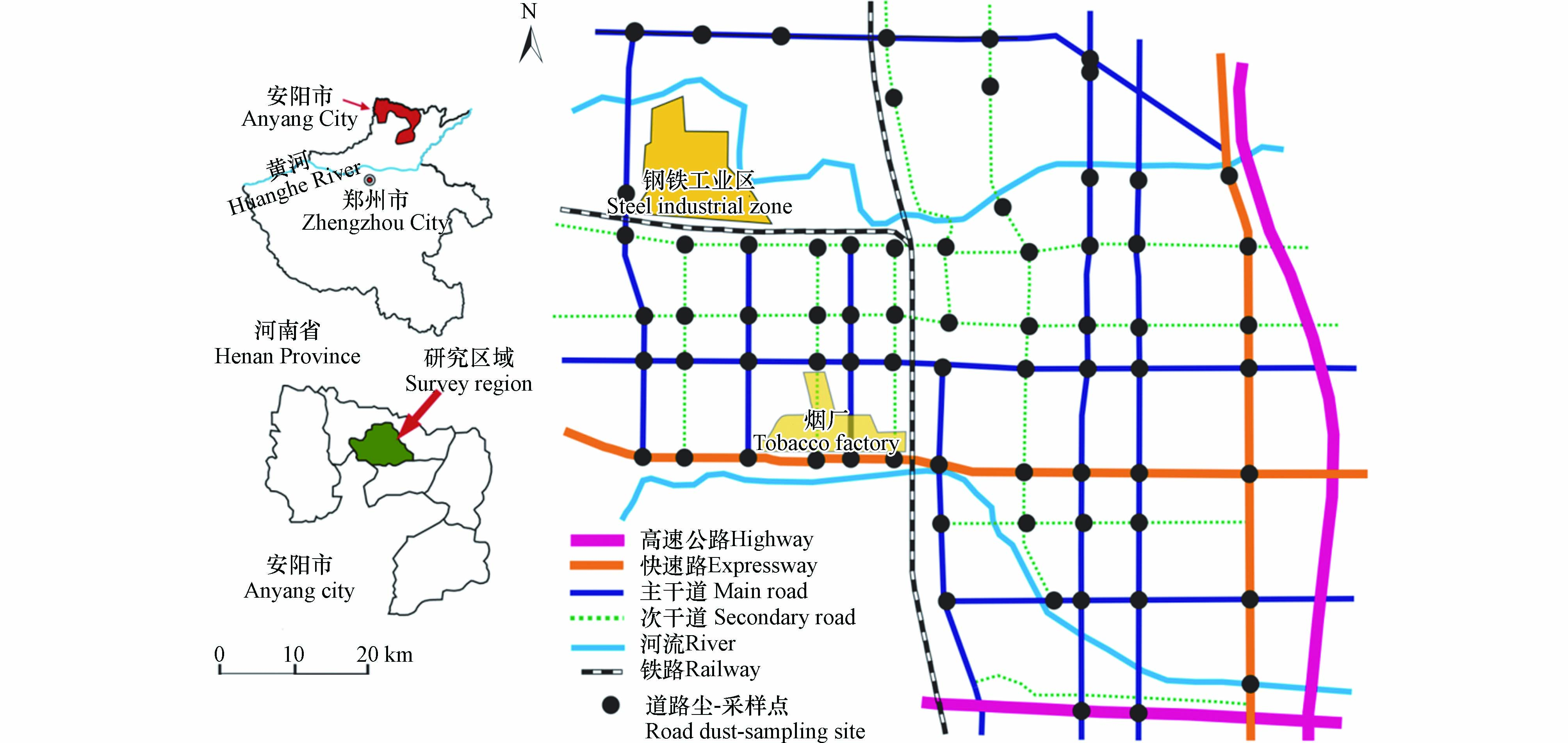
 下载:
下载:






















